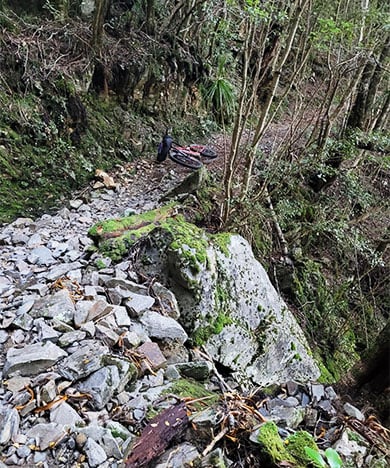Rules
- Bikers must give way to walkers.
- Night riding is not permitted.
- Electric bikes are not allowed on the track.
- You're not permitted to take a mountain bike into any hut or shelter, or onto hut porches.
You're responsible for:
- obeying the mountain bikers code. The track is shared with hikers and other bikers – show respect for other users.
- following signs and other markers that clearly identify where mountain bikes can be ridden and where they are not allowed
- removing your bike from the national park should it break down.
- obeying the closure of the track to mountain bike use. This will usually be after storms, heavy rain, snow or high-tide events, which may damage the track, particularly on the West Coast side.
When you can mountain bike
 Example of drops by track and terrain
Example of drops by track and terrain
Image: Nick Sutcliffe | DOC
You can mountain bike the Heaphy Track in the winter season from 1 May to 30 November. Walkers will also be on the track during this time.
Where you can bike
You can ride mountain bikes on the Heaphy Track:
- in both directions
- in a group, provided there are no more than 6 riders in the group
- during the day only from half an hour before sunrise to half an hour after sunset. This is to protect two threatened nocturnal species found on parts of the track: the Powelliphanta snail and roa (great spotted kiwi).
You are not permitted to take a mountain bike:
- in or out of the national park by helicopter
- into any hut or shelter, or onto hut verandas or porches
- off the formed and designated route.
Track advice
The Heaphy Track is a tough ride – it is not a cycle trail.
To ride safely, you need to be fit, experienced, have good equipment and ideally have tested it out before arriving on the track.
The track is suited to riders that can do advanced Grade 4 mountain biking tracks. Fit, experienced riders should plan for two full days, staying overnight in a hut or designated campsite. Less experienced riders should anticipate a 3 day, 2-night trip.
Mountain bike track grade description
You can expect:
- a well-formed 78.4 km track maintained to DOC Great Walk standard
- bike stands at Perry Saddle, Gouland, Saxon, James Mackay and Heaphy huts
- numerous bridges, like swing and suspension, bridges
- some rough track on the West Coast side. This area is more vulnerable to damage from rutting and erosion
- changeable weather, including extremely cold temperatures, rain, wind and possibly snow. There are steep slopes, many bridges, avoidable obstacles and sections of track prone to deep flooding.
- some steep drops beside the track
Watch out for takahē and the giant land snail:
- takahē have been released into Gouland Downs and are sometimes seen on or near the track. Ride with caution in this area
- the giant land snail, Powelliphanta, maybe on the track during the day, particularly after rain Ride carefully and slowly through these areas, which are marked by signs – these snails are rare and unique to this part of New Zealand.
Beware:
- of tight corners and slippery rock between James Mackay Hut and Lewis Shelter
- of steep drops beside the track, especially between the turnoff to Shakespeare Flat and the lookout at Flanagans Corner, and on the descent to Lewis Shelter
- kea at James Mackay Hut have become attracted to bike seats and hydraulic brake lines When staying overnight in a hut, remove your seat from your bike, keep it with your other personal items, and cover your brake lines
- flooding in the Saxon/James Mackay section and the lower Heaphy Valley can reach 1.5 metres deep over the track. Be prepared to wait until it’s safe to continue, or return to James Mackay Hut
- a section between Heaphy Hut and Kohaihai Shelter is on a sandy beach. High tide or rough seas may delay your ride.
Fitness and what to take
You need to have a good standard of fitness, a reliable bike, and to carry all your food, clothes, overnight and personal gear, and bike tools and equipment.
This is a backcountry environment where you need to be self-reliant. At least one member of your party should know how to fix a bike.
If you plan to stay overnight, book your huts or campsites. Take your hut or campsite ticket with you if that is what you're using.